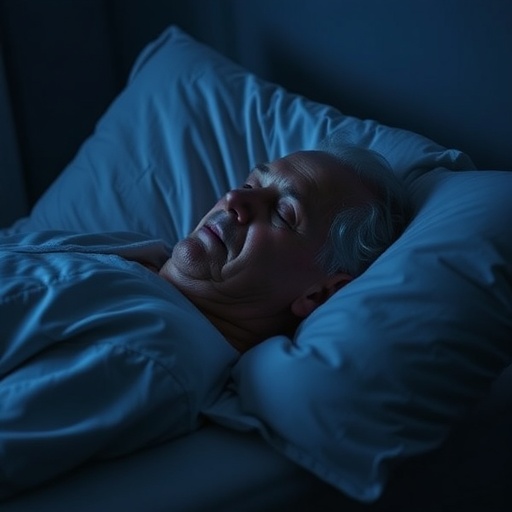In a groundbreaking study emerging from Taiwan, researchers have unveiled a stark connection between sleep duration, the likelihood of sleep apnea, and the peril of osteoporosis among older adults residing in elder care institutions. This extensive cross-sectional investigation, conducted by a team led by Chen, HJ., and including notable contributors Ou, H. and Chen, RY., delves deep into the complexities of these interrelated health issues that challenge our aging populations. As the study presents compelling evidence, it stands to change our understanding of how sleep significantly influences skeletal health, particularly as individuals transition into their later years.
At the core of this investigation lies the understanding that sleep is not merely a period of rest but a critical component of overall health, particularly for older adults. As the body ages, its physiological processes become more susceptible to interruptions, giving rise to conditions like sleep apnea. This condition not only disrupts sleep but also has broader implications for metabolic health, cognitive function, and now, as this study reveals, even bone density. The risks associated with sleep apnea are amplified when sleep duration is inadequate, creating a ripple effect on various health aspects, especially osteoporosis, which has long been a hidden crisis in geriatric care.
Osteoporosis, characterized by a decrease in bone density and an increased risk of fractures, is not merely a side effect of aging. Rather, it is a pressing public health challenge that disproportionately affects older adults. The study from Taiwan sheds light on how sleep disturbances can exacerbate this condition. The researchers collected extensive data from elder care facilities, highlighting that insufficient sleep and sleep apnea were associated with lower bone mineral density. These findings suggest that improving sleep quality and duration may be a vital strategy in combating osteoporosis, potentially reshaping practices in elder care.
The prevalence of sleep apnea among older adults is alarming, estimated to affect nearly one in four individuals over the age of 65. Symptoms can range from loud snoring to debilitating fatigue during the day, and many go undiagnosed. This study underscores the potential of routine sleep assessments in geriatric populations to identify at-risk individuals. By recognizing and treating sleep apnea, care providers could not only improve sleep quality but also significantly reduce the risk of osteoporosis, thus fostering healthier aging.
The significance of sleep in the context of bone health can be traced back to various physiological mechanisms. Sleep plays a crucial role in modulating hormones that regulate bone remodeling, including calcitonin and parathyroid hormone. Disruptions caused by sleep apnea could lead to an imbalance in these hormones, ultimately influencing bone turnover negatively. Furthermore, sleep assists in muscle recovery, and impaired muscle function increases fall risk, leading to fractures in osteoporotic patients. Therefore, the interplay between sleep apnea, inadequate sleep, and osteoporosis forms a triad of risks that should not be overlooked.
Moreover, the study’s methodology adds to the credibility of its findings. Utilizing a cross-sectional design, the researchers analyzed a large cohort of older adults in various elder care institutions across Taiwan. Their rigorous statistical analyses factored in a wide array of variables, including demographic factors, lifestyle behaviors, and pre-existing health conditions. This comprehensive approach ensures that the connections drawn in the findings are robust, minimizing the risk of confounding biases that could undermine the study’s conclusions.
Holistically, the implications of these findings extend beyond medical research; they touch on the very fabric of elder care policies. The integration of sleep assessments into regular health checks for the elderly could serve as a standard practice, allowing care facilities to implement strategies that prioritize sleep health. Education and training for caregivers about the importance of sleep in maintaining skeletal integrity should become a focal point in geriatric care curricula.
In light of this research, stakeholders in public health must advocate for advancements in sleep research and awareness initiatives. Policymakers can harness this evidence to promote funding for sleep studies targeted at the geriatric population while simultaneously ensuring better access to diagnostic tools for conditions like sleep apnea. Such proactive steps could alleviate the burden of osteoporosis, thereby enhancing the quality of life for countless older adults.
A pivotal aspect of the study also brings to light the cultural context of sleep hygiene in Taiwan and how it may differ from Western practices. The research indicates that societal attitudes towards napping and sleep may play a role in the reported sleep duration, raising questions about how cultural perceptions of sleep impact older adults’ health. This opens the door for comparative studies that could illuminate global patterns in sleep disorders and their health ramifications.
As the research community continues to unveil the multifaceted relationship between sleep and bone health, the findings serve as a clarion call for further investigation. Future research should explore longitudinal data to better understand the causative mechanisms linking sleep duration with osteoporosis. Such inquiries could pave the way for targeted interventions aimed at integrating sleep health into osteoporosis prevention strategies.
In conclusion, the study by Chen et al. profoundly alters the dialogue surrounding the importance of sleep among older adults, illuminating the potential for sleep interventions to play a critical role in osteoporosis management. As awareness grows regarding the connections between sleep patterns and systemic health, it becomes imperative to act on these findings to enhance the well-being of aging populations. Researchers, healthcare providers, and policymakers must work collaboratively to improve sleeping conditions and thereby promote healthy bones in our elders.
In essence, poor sleep should no longer be viewed as a benign issue but rather as a public health concern that holds substantial implications for our aging society. As the conversation around sleep gains traction, one thing remains clear: prioritizing sleep health could yield monumental benefits for older adults, greatly reducing the burden of osteoporosis and enhancing their overall quality of life.
Subject of Research: Association between sleep duration, sleep apnea risk, and osteoporosis in older adults.
Article Title: Association between sleep duration, sleep apnea risk, and osteoporosis in older adults: a cross-sectional study in elder care institutions in Taiwan.
Article References:
Chen, HJ., Ou, H., Chen, RY. et al. Association between sleep duration, sleep apnea risk, and osteoporosis in older adults: a cross-sectional study in elder care institutions in Taiwan. BMC Geriatr 25, 851 (2025). https://doi.org/10.1186/s12877-025-06527-y
Image Credits: AI Generated
DOI: https://doi.org/10.1186/s12877-025-06527-y
Keywords: Sleep duration, sleep apnea, osteoporosis, older adults, elder care, Taiwan, public health, bone health, geriatric care, sleep assessments.
Tags: aging populations and bone healthcognitive function and sleep qualitycross-sectional study on sleepelder care and sleep disordershealth implications of sleep deprivationinterrelated health issues in elderlymetabolic health and sleeposteoporosis crisis in seniorssleep apnea in older adultssleep duration and osteoporosis risksleep quality and agingsleep’s impact on skeletal health





